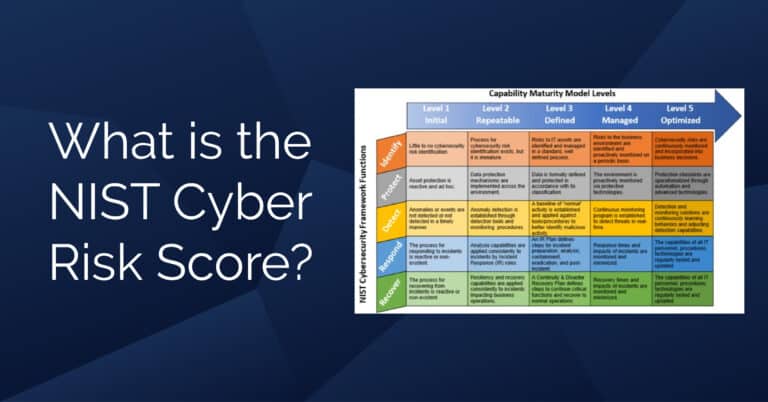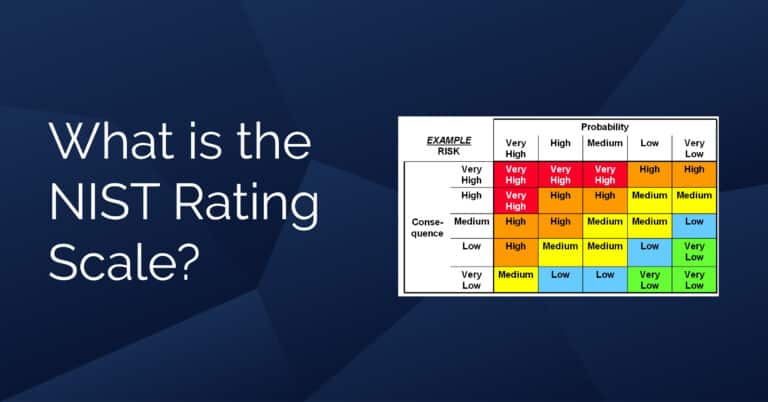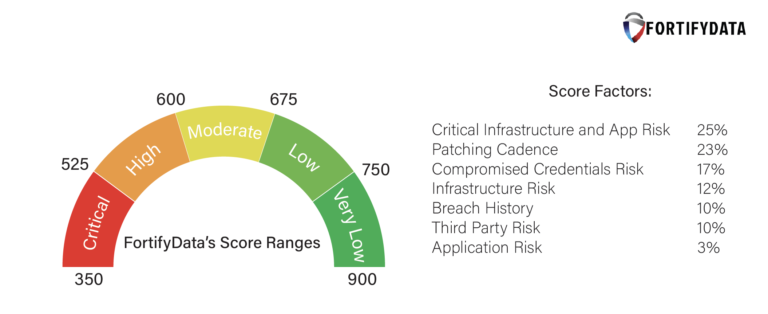
What is the NIST cyber risk score? In the ever-evolving landscape of cyber security, staying ahead of threats and…
"This is an excellent starting point for any organization that wants to get serious about their cyber risk management. The system has the capability to grow as you become more sophisticated in your use"
IT Director
Services Industry
In the ever-evolving landscape of cyber threats, organizations are constantly seeking ways to assess and strengthen their security posture. Enter the NIST Cybersecurity Framework (CSF), a comprehensive framework that provides a roadmap for managing cybersecurity risks and improving overall security. But what about the NIST CSF score? This often-mentioned metric can be shrouded in mystery, leaving many wondering: “What is a NIST CSF score, and how does it impact my organization?”
Let’s break down this crucial concept and explore its significance for your cybersecurity risk management program.
Before diving into the specifics of the NIST CSF score, it’s helpful to understand the broader context of security ratings. These ratings, often presented on a tiered scale, offer a standardized way to evaluate an organization’s security posture. Similar to how credit scores assess financial health, security ratings provide a snapshot of your organization’s cybersecurity preparedness. By referencing a cyber security rating scale or the NIST rating scale, you can gain valuable insights into your strengths and weaknesses, enabling you to prioritize vulnerabilities and improve your overall risk posture.
Contrary to popular belief, the NIST CSF score is not a single numerical value. Instead, it’s a methodology for assessing and quantifying risk based on the principles outlined in the NIST Cybersecurity Framework. The NIST Cybersecurity Framework is one of a list of NIST frameworks, some of the more frequently used in the list of NIST frameworks are further discussed below.
The NIST CSF methodology involves identifying relevant security controls, assigning weights to each control based on its importance, and then evaluating the effectiveness of those controls within your organization. The resulting score, often presented as a NIST CSF scorecard, paints a picture of your risk posture, highlighting areas where you excel and pinpointing areas demanding attention.
Additional Resources
Cybersecurity rating scale explained
What are security ratings used for?
How are security ratings created?
What is a good cybersecurity rating?
How do you improve your security rating?
Is it easy to switch security ratings providers?
Why is my security rating wrong?
What Kind of Company is BitSight?
What is the Highest Security Rating?
Select What are the 5 C’s of Cybersecurity?
What is the difference between SecurityScorecard and BitSight?
What is the difference between BitSight and RiskIQ?
What is the difference between SecurityScorecard and CyberGRX?

Source: NIST, Uses and Benefits of the Framework, https://www.nist.gov/cyberframework/online-learning/uses-and-benefits-framework
The NIST CSF Maturity Scale, an integral part of the scoring methodology, provides a structured approach for evaluating your security controls and determining their effectiveness. This scale, often presented as a NIST risk Scoring matrix, ensures a comprehensive and standardized assessment process, allowing you to compare your organization’s performance to industry benchmarks.
Imagine a sturdy ladder stretching towards the sky, each rung representing a step towards a more secure cyber posture.
That’s the essence of the NIST Cybersecurity Framework (CSF) Maturity Scale, a vital tool in your cybersecurity arsenal. This scale provides a clear roadmap for organizations to ascend the rungs of security maturity, offering a structured approach to measuring and enhancing their risk management efforts.
But what does this “ladder” look like, and how does it translate into your organization’s security reality?
Think of the NIST CSF scorecard as your individual rung on this ladder. This comprehensive document, generated through a NIST assessment, assigns scores to your organization’s implementation of the five core functions of the NIST CSF: Identify, Protect, Detect, Respond, and Recover.
Each function is further divided into subcategories, delving deeper into specific areas like vulnerability management, incident response planning, and business continuity.
The magic of the maturity scale lies in its tiered structure. Each function is assigned a level ranging from “Partial” to “Adaptive,” representing increasing degrees of maturity and effectiveness. Imagine reaching the “Adaptive” level for “Detect,” signifying your organization employs proactive threat hunting and advanced anomaly detection techniques. Conversely, a “Partial” rating in “Protect” might highlight a need to strengthen access controls and data encryption practices.
By analyzing your scorecard, you can pinpoint your exact rung on the ladder and identify the next steps to climb higher. For instance, if your “Respond” function sits at “Reactive,” indicating a focus on incident containment rather than proactive recovery, you might prioritize investing in incident response training and disaster recovery planning.
The NIST CSF Maturity Scale isn’t just about reaching the top. It’s about continuous improvement, using your scorecard as a compass to navigate your journey towards a more secure future. Much like the cybersecurity rating scale provided by security ratings, it is meant to help as a guide to monitor risks and identify areas of improvement- some more impactful to your business than others. By focusing on the highest-risk areas identified by your assessment, you can systematically strengthen your defenses, one rung at a time.
Remember, in the ever-evolving landscape of cyber threats, standing still is the same as falling behind.
Embrace the NIST CSF Maturity Scale as your guide, ascend the ladder of security maturity, and build a fortress-like cybersecurity posture that protects your organization from the ever-present dangers of the digital world.
The process of evaluating cybersecurity risks within the NIST framework is termed as NIST cybersecurity risk scoring. This encompasses utilizing the NIST cybersecurity framework alongside a NIST risk assessment template to carry out a systematic assessment of cybersecurity risks faced by an organization and can be presented within a NIST risk scoring matrix. The score range as mentioned in the table below helps weight the factors being evaluated in the NIST assessment and populated in the NIST CSF scorecard. Scoring helps in prioritizing risks and allocating resources efficiently to address the most critical vulnerabilities. This provides an “integrated view of NIST risk posture across the enterprise with quantitative metrics across systems and components”
“Risk Scoring provides a foundation for quantitative risk-based analysis, assessment, and reporting of organizational IT assets. By applying ratings to controls and generating scores for components, stakeholders have a relative understanding of risk from one system compared to another. The variables that can affect a control’s potential risk score is outlined below.”

The term “NIST assessment” can sometimes feel like a cryptic riddle in the world of cybersecurity. While it’s often associated with the NIST Cybersecurity Framework (CSF) and its scoring system, there’s more to it than meets the eye. So, let’s unravel the mystery and explore what exactly a NIST assessment entails.
First, it’s important to understand that a NIST assessment isn’t a singular, monolithic entity. Instead, it’s an umbrella term encompassing various evaluation methodologies based on different NIST frameworks, in fact there is a list of NIST frameworks to select for your needs. Some of the more common ones are below. Think of it as a toolbox filled with specialized tools, each designed to assess specific aspects of your security posture.
Here are some prominent examples of these tools within the NIST assessment toolbox:
Choosing the right tool from the NIST assessment toolbox depends on your specific needs and goals. Do you want a comprehensive evaluation of your overall security posture? The NIST CSF might be the best choice. Are you more concerned about identifying vulnerabilities in your systems or need to meet FedRAMP requirements? A SP 800-53 assessment could be the answer. And if you’re worried about security risks lurking within your supply chain, the SCRM framework offers a valuable solution.
Now, let’s connect the dots and see how these tools relate to the concept of a NIST rating scale and the NIST CSF scoring tool. Both of these elements come into play when using the NIST CSF framework.
In essence, a NIST assessment acts as a personalized evaluation, using the right tool from the NIST toolbox to assess your specific security needs. Whether you’re looking for a holistic view of your cybersecurity posture or a targeted assessment of your systems or supply chain, there’s a NIST assessment waiting to illuminate your vulnerabilities and empower you to build a more robust defense.
Ready to take control of your cybersecurity posture? Contact us today to learn more about how we can help you understand your cybersecurity posture with an automated cyber threat assessment, which produces a security rating, and the assessment findings can be used in a NIST based assessment to understand how your organization is scored against NIST risk assessment and cybersecurity posture.



| Cookie | Duration | Description |
|---|---|---|
| cookielawinfo-checkbox-analytics | 11 months | This cookie is set by GDPR Cookie Consent plugin. The cookie is used to store the user consent for the cookies in the category "Analytics". |
| cookielawinfo-checkbox-functional | 11 months | The cookie is set by GDPR cookie consent to record the user consent for the cookies in the category "Functional". |
| cookielawinfo-checkbox-necessary | 11 months | This cookie is set by GDPR Cookie Consent plugin. The cookies is used to store the user consent for the cookies in the category "Necessary". |
| cookielawinfo-checkbox-others | 11 months | This cookie is set by GDPR Cookie Consent plugin. The cookie is used to store the user consent for the cookies in the category "Other. |
| cookielawinfo-checkbox-performance | 11 months | This cookie is set by GDPR Cookie Consent plugin. The cookie is used to store the user consent for the cookies in the category "Performance". |
| viewed_cookie_policy | 11 months | The cookie is set by the GDPR Cookie Consent plugin and is used to store whether or not user has consented to the use of cookies. It does not store any personal data. |